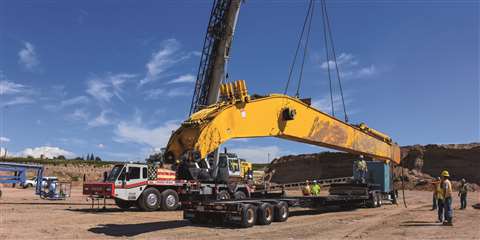Truck cranes: The road ahead
15 May 2018
Truck cranes and truck-mounted cranes continue to be popular. This is reflected in ongoing manufacturer development of new product lines and updates. Christian Shelton reports
New in the truck mounted crane sector is the AK 52 truck-mounted crane from German manufacturer Böcker. The AK 52 has a maximum payload of 12 tonnes and an extension length of 52 metres (optional 55 m). The crane is made from aluminium and steel and has a hybrid telescopic mast system with a 45 metre reach and an endless pivoting range.
According to Böcker, the AK 52 can extend a one-tonne load to a distance of 34 metres while reaching a height of up to 30 metres. The telescopic boom is radio controlled and Böcker says, due to the AK 52’s powerful cylinder technology, it can extend completely without changing its mast angle – even when in an almost vertical position.

Böcker’s new AK 52 truck-mounted crane lifts 12 tonnes and offers an extension length of 52 metres
The AK 52 is also steered by the rear-axle and has a compact design with a small tail swing radius which Böcker says makes it flexible in tight spaces. When maximum reach is attained the swing radius is 2.2 metres, and the turret protrudes just 0.9 m beyond the frame of the carrier vehicle. This is possible because the crane does not need to have retractable counterweights, says Böcker.
Variable support positions and a large support lift with a high ground clearance also facilitate setup on site, says Böcker, while sensors on each support are designed to provide the optimal ground load distribution and ensure that the axles retract automatically during levelling.
The crane is powered via an auxiliary drive on the truck which, Böcker claims, consumes less fuel and requires less maintenance than using a separate ancillary drive. It also facilitates handling, since refuelling only has to take place once, Böcker adds, while a large tank volume on the truck is designed to enable the crane to be operated for longer.
The crane will be equipped with an intelligent control system and a radio remote control system with a graphic display which, Böcker says, makes it crane easy-to-use and safe. The control technology has an automatic setup control, an auto-levelling function, and a ‘go-home’ function for dismantling. Optional camera technology, with a camera mounted permanently on the mast, enables the operator to control blind spots on the radio control display during crane operation.
Application expansion
We remain in Germany, where Tadano Faun has updated its HK 40 truck-mounted crane. The company says that changing the HK 40’s superstructure engine to be Euromot 4 exhaust emission compliant gave it the impetus to continue optimising the crane.
As a result, the crane’s counterweight allocation has been modified enabling it to transport a total counterweight of 5.5 tonnes instead of 4.5 tonnes, which is in the scope of a special permit for a gross vehicle weight of 33 tons, depending on the truck chassis. The company says this means the HK 40’s performance can be increased considerably, expanding its range of applications.
Tadano Faun says the crane also has a new asymmetric outrigger base, as found on its all terrain cranes (ATs), which also expands its application possibilities. The HK 40’s crane control system enables the maximum possible lifting capacities for each sector of the four outriggers, says Tadano. The updated HK 40 also has a centralised lubrication system in the superstructure and improved access to relevant maintenance components, Tadano adds.
This ‘borrowing’ of asymmetric outrigger base technology from its ATs by Tadano Faun is an interesting development although Wolfgang Beringer, Liebherr spokesperson, maintains that “truck-mounted cranes will not replace all terrain cranes but instead provide an economic alternative, especially when driving long distances.”
Liebherr produces two truck-mounted crane models – the LTF 1045-4.1 and the LTF 1060-4.1 – both of which, Beringer says, are popular with customers working in the prefabricated housing installation sector.

Liebherr says its truck-mounted cranes are proving popular with customers working in the prefabricated housing installation sector
According to Beringer, other benefits of using truck-mounted cranes include, “advantages in terms of tyres and other parts subject to wear, since these are produced in large quantities. Trucks can be obtained, if required, with a sleeper cab – which may offer additional cost benefits for certain types of crane operation – while a standard truck chassis, by virtue of its design, has lower fuel consumption than a comparable all terrain crane.” They also have advantage of lower axle loads which makes it is easier to gain road permissions, Beringer adds.
The same applies to truck cranes. “A truck crane, by definition, has a purpose-built chassis. This means we can integrate the lifting performance of a truck crane into the transportation performance of the crane,” concurs Rick Curnutte, product manager for telescopic truck and all terrain cranes at US crane manufacturer Link-Belt. “This makes a truck crane more cost effective and less complex than say, an all terrain crane or a lattice crawler crane.”
Michelle Respicio, product marketing manager at manufacturer Terex, echoes both Beringer and Curnutte. “Truck cranes with a purpose-built chassis allow integration of standard components, from the engine to the tyres, which facilitates maintenance and helps with maintenance costs, comparable with commercial carriers,” he says. “On the other hand, our truck-mounted cranes can offer increased highway speeds and smoother ‘roadability’ than a purpose-built chassis.”
Seventieth anniversary
In other truck-mounted crane news, US manufacturer of truck mounted material handling work platforms, cranes and digger derricks, Elliott Equipment Company, is celebrating its 70th anniversary in 2018. The company was founded in 1948 by Dick Elliott in Omaha, Nebraska, where it is still based, and claims to have been one of the pioneers in developing truck mounted aerial equipment.
Elliott says its products were adopted early by electrical contractors and utilities companies as post-war America constructed its electrical grid. Its HiReach aerial lift was also used by state and municipal transportation departments for sign and lighting installation and maintenance during the building of the interstate highway system, Elliott explains.
Elliott’s boom truck line covers rated capacities from 10 to 50 US tons (9 to 45 tonnes) with a range of boom lengths and tip heights up to 207 feet (63 metres). Its latest model is the 36 ton (33 tonne) capacity 36142 BoomTruck telescopic truck-mounted crane which, the company claims, has the longest boom in its class. With a five-section, 142 ft (43 m) main boom and an optional 32 – 49 ft (10 – 15 m) two-section jib, the 36142 offers a maximum tip height of 201 ft (61 m).
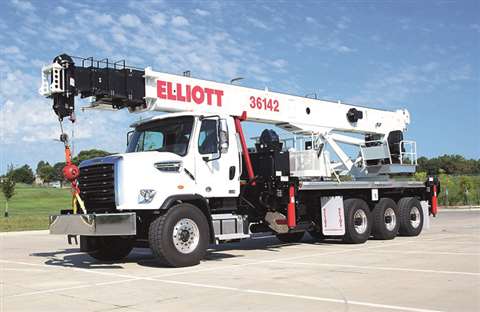
Elliott’s latest model is the 33 tonne capacity 36142 boom truck
Elliott still enjoys custom from the US government. For example, it provided the Michigan Department of Transportation (DoT) with a customised 26 ton (24 tonne) crane, with a 105 foot (32 m) tip height and digger attachment for installation work and repairing and replacing large overhead signs and their supporting structures. According to Elliott this solution allowed the DoT to handle heavy structures and signs and dig holes up to 48” (122 cm) in diameter with an equipped 20,000 ft-lb hydraulic auger for setting vertical assemblies. In addition, the machine has wireless radio remote controls, a conspicuity light bar, an air compressor for powering the crew’s tools (which are mounted to the custom 20 foot bed (6 m).
First Grove TMS9000-2 in Canada
US manufacturer Manitowoc has delivered the first Grove TMS9000-2 in Canada. The truck-mounted crane went to crane services firm R&D Crane Rental (R&D) in Burnside, Nova Scotia, where it was used straightaway to hoist formwork panels at radii ranging from 140 to 150 ft (43 – 46 m) for the construction of a new Marriott-branded hotel in Halifax, Nova Scotia.
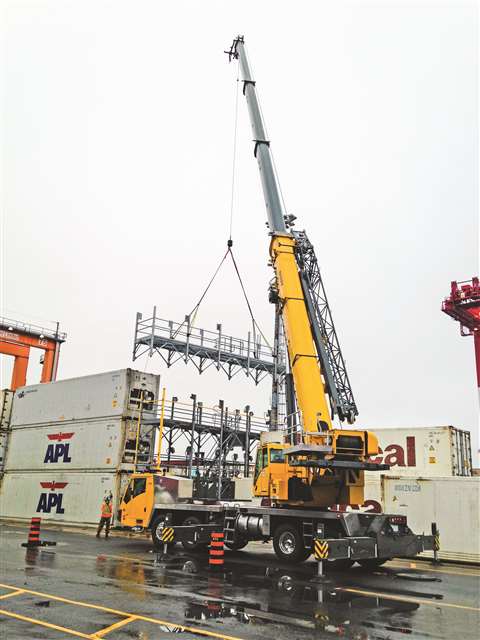
R&D Crane Rental’s says its new Grove TMS9000-2 has helped save hours of work as there is no need to add and remove a swingaway jib
The Grove TMS9000-2 is Manitowoc’s most recent truck crane model, launched in February 2017. It has a capacity of 100 tonnes and a six-section greaseless Megaform boom that extends from 11.2 m to 51.6 m. The boon also has Manitowoc’s Twin-Lock boom pinning system. “The main selling point for us was the longer main boom,” says Alex Jenkins, operations manager at R&D. “That extra reach has saved us hours on the job since we don’t have to take a swingaway jib on and off the crane.
“The TMS9000-2 has a comparable gross weight to that of a lower-capacity crane, but you also get extra boom length. This makes it easier to get proper road permits in our region. The crane has worked almost every day since we acquired it. It gives us the reach we need to adapt to a wide range of job sites.”
Truck cranes
Important news in the truck crane sector is that Japanese crane manufacturer Tadano is launching a new truck crane series comprising the GT-300EL, GT-600EL, and GT-750EL. The GT-300EL has a maximum lifting capacity of 30 tonnes, a boom length of 34 m, and a lifting height of 34 m. The GT-600EL has a maximum lifting capacity of 60 tonnes, a boom length of 43 m, and a lifting height of 43.4 m. And the GT-750EL has a maximum lifting capacity of 75 tonnes, a boom length of 47 metres, and a lifting height of 47.3 m. The load radii are: 32 m for the GT-300EL; 34 m for the GT-600EL; and 40 m for the GT-750EL.
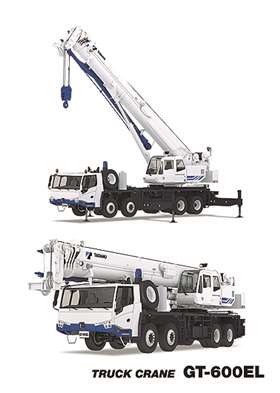
The cranes have a rounded boom constructed from high tensile steel. Extra reach is provided by a two-stage (9 m / 14.3 m, 8.5 m / 14 m) under slung jib which Tadano says makes installation in narrow spaces simple. It extends the lifting heights to: 48 m for the GT-300EL; 57.3 m for the GT-600EL; and 61.2 m for the GT-750EL.
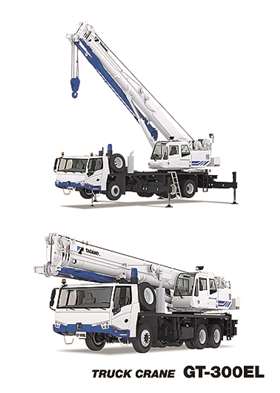
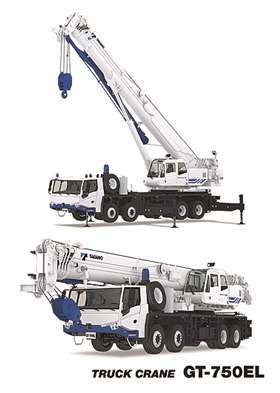
The truck cranes have new carriers that are equipped with leaf suspension at the front and rubber mounted suspension at the rear. The rear suspension was developed in collaboration with heavy-duty suspension specialist Hendrickson. The transmission is automatic and it has cruise control.
With Tadano’s new Smart Chart control system the cranes can achieve a square-shaped rated load capacity footprint with extended ‘corners’ over the rear outriggers. This, Tadano claims, increases the load radius depending on the degree to which the outriggers are extended.
The new series has Tadano’s fuel monitoring system which has Eco-Mode to reduce fuel consumption and Positive Control which reduces fuel consumption when the crane is on standby. The cranes also have Tadano’s Hello-net telematics system that enables users to monitor crane activity, work history, machine position data, and maintenance information.
The future
Looking to the future, the road ahead looks positive for the truck crane and truck-mounted crane sector. “We see growth coming from the taxi crane industry (multiple picks), refinery work and urban development,” says Respicio at Terex. “We are currently developing a high capacity truck crane along with improving our Crossover product line.”
Link-Belt’s view of the future is upbeat, too. “For 2018 we expect to see a steady market with growth,” claims Curnutte. “The real key is to stay ahead of the customer; that is why we’ve added operator comforts.” These can be seen in the form of radios for the operator’s cab and driver’s cab, LED cab lights, halogen headlights, guard rails and operator cameras on Link-Belt’s HTC-86110.
Link-Belt finishes by saying that one of the main themes for 2018 in the truck crane market is that it is not a market to overlook. “Multiple manufacturers have returned with new products at the end of 2017 showing the importance, across the world, for truck cranes,” concludes Curnutte.
